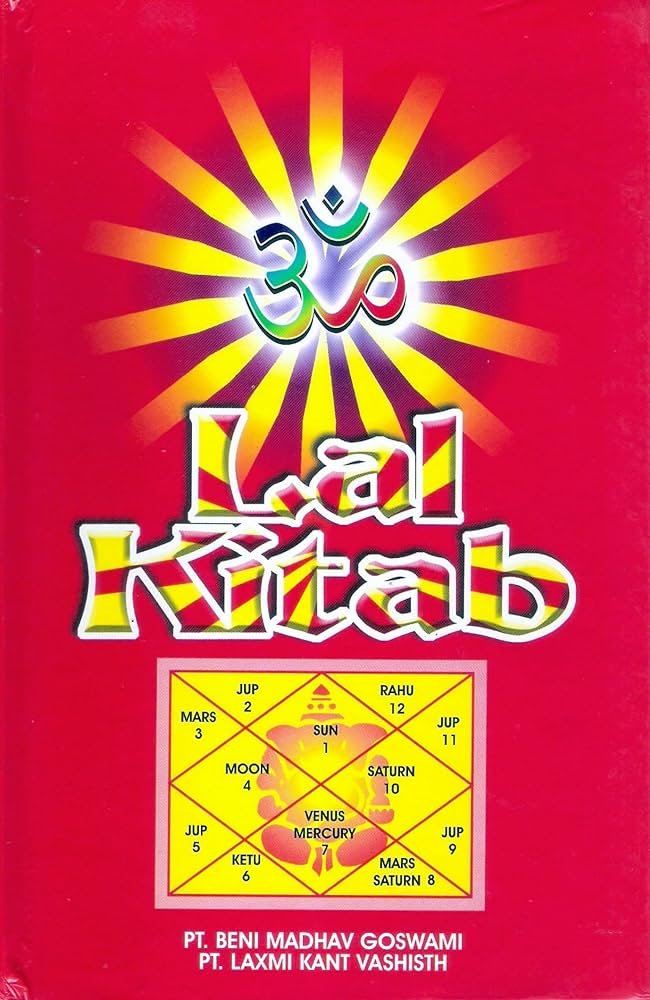Introduction
Lal Kitab, often referred to as the “Red Book,” is a set of five Urdu-language books on astrology and palmistry, written in the 20th century. It has gained immense popularity for its unique approach to Vedic astrology and its remedies, which are considered easy to implement and effective. The book combines traditional Indian astrology with practical solutions that resonate with both famous astrologers and general people.
Origins and History
Lal Kitab is believed to have been written by Pandit Roop Chand Joshi, although there is some debate about its true authorship. It originated in the early 1900s and quickly became known for its straightforward astrological remedies. Unlike classical astrology texts, which are often complex and require extensive study, Lal Kitab offers practical guidance in everyday language, making it accessible to a wider audience

Astrological Principles
One of the defining features of Lal Kitab is its simplified astrological principles. It deviates from traditional Vedic astrology by focusing more on planetary positions in the twelve houses rather than zodiac signs. This approach allows for a more intuitive understanding of an individual’s horoscope and provides clear insights into their life’s challenges and opportunities.
Remedies
Lal Kitab is particularly renowned for its remedies, known as “Upayas.” These remedies are designed to solve the adverse effects of planetary positions and enhance positive influences in human life. Unlike the complex rituals found in traditional astrology, Lal Kitab remedies are practical and easy to perform. They often involve simple actions such as donating specific items, feeding animals, or making lifestyle adjustments.
Relation with Palmistry and Face Reading
In addition to astrology, Lal Kitab incorporates elements of palmistry and face reading. It provides guidelines on how to explain various lines on the palm and features of the face to gain deeper insights into an individual’s character and destiny. This integration of disciplines offers a holistic approach to understanding human nature and potential.
Practicality and Accessibility
Lal Kitab remedies are known for their practicality and ease of implementation. They are designed to be accessible to people from all walks of life, regardless of their financial or social status. This democratization of astrology has contributed to the book’s widespread popularity and enduring relevance.
Personal Responsibility
Another significant aspect of Lal Kitab is its emphasis on personal responsibility. The remedies often encourage individuals to adopt positive behaviors and attitudes, promoting self-awareness and personal growth. By taking proactive steps to improve their lives, people can harness the positive energies of the planets and minimize negative influences.
Cultural Impact
Lal Kitab has had a profound cultural impact, particularly in India and neighboring countries. Its teachings have influenced not only astrologers but also filmmakers, writers, and artists, who often incorporate its concepts into their work. The book’s practical approach to astrology has made it a valuable resource for those seeking guidance and inspiration in their daily lives.
Criticism and Controversies
While Lal Kitab has garnered a devoted following, it has not been without criticism. Some traditional astrologers argue that its simplified methods lack the depth and rigor of classical astrology. Others question the authenticity of its authorship and historical origins. Despite these controversies, Lal Kitab remains a popular and influential text, appreciated for its practical insights and remedies.
Conclusion
Lal Kitab stands as a testament to the enduring power of astrology to provide guidance and comfort in an ever-changing world. Its unique blend of simplicity, practicality, and accessibility has resonated with generations of seekers, offering them a roadmap to navigate the complexities of life. Whether one is a seasoned astrologer or a curious novice, Lal Kitab continues to inspire and empower individuals on their journey of self-discovery and fulfillment.




